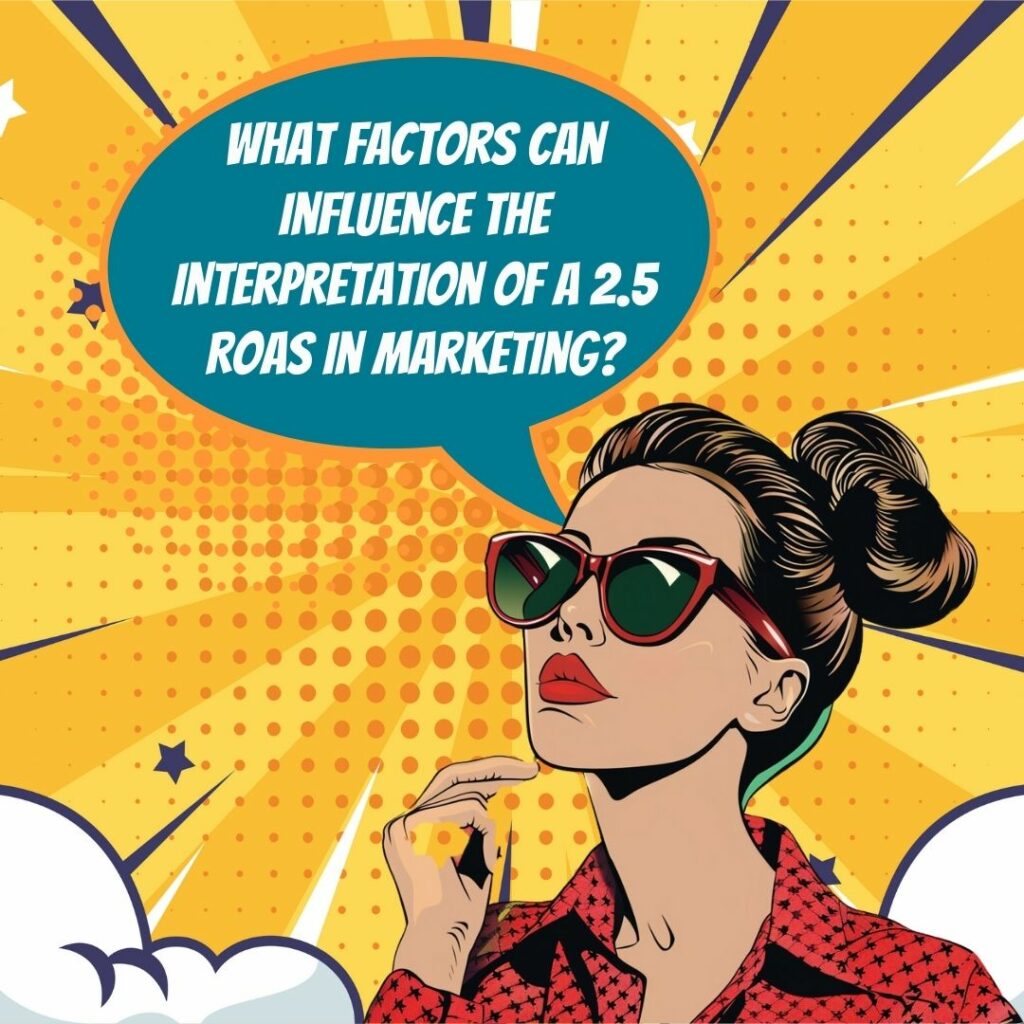Key Takeaways
✅ Return on Advertising Spend (ROAS) is your performance indicator, pitting every penny you spend against your earnings from ads. It’s your campaign’s report card telling you how smart your investment is.
✅ Hitting a 2.5 ROAS is like turning water to wine in the marketing world. You invest a dollar and get back a lovely $2.50. It’s the sweet spot that says you’re getting more bang for your buck.
✅ Why is a 2.5 ROAS your gold standard? Because it’s proof that your ad campaigns are not just for show—they’re filling up your coffers and fueling your business growth.

Introduction
Have you ever wondered if your ads are just a shot in the dark or a strategic move in the chess game of marketing? What does a 2.5 ROAS mean for your business, and why should you care? Let’s demystify this acronym that keeps popping up wherever marketers mingle. It’s not just a number; it’s a milestone, a badge of honor in the realm of advertising effectiveness. In this guide, we’re going to peel back the layers on ROAS and show you how it’s calculated, why it’s crucial, and how you can boost yours sky-high.
Ready to fire up your ad campaigns and see your revenue soar? Stay tuned, because we’re about to embark on an excursion into the world of ROAS that promises tons of actionable insights and game-changing strategies. Let’s turn those ads into a well-oiled machine that works tirelessly for your bottom line.
Top Statistics
| Statistic | Insight |
|---|---|
| Global digital ad spend: Projected to reach $455.3 billion in 2021. (eMarketer, 2021) | With such a breathtaking amount being poured into digital ads, it’s clear that businesses are betting big on capturing attention online. |
| Average ROAS for search ads: Stands at 2.5, aligning with our focus figure. (WordStream, 2021) | Seeing that 2.5 is the average ROAS for search ads, it’s a solid baseline to compare and contrast your own ad performance. |
| E-commerce industry average ROAS: Hits 3.77, a step up from the general average. (BigCommerce, 2021) | For those in e-commerce, knowing that the bar is set at 3.77 could be a wake-up call to optimize ad spend for improved returns. |
| Top vs. bottom ROAS performers: The best achieve 11.45, the worst, just 0.35. (BigCommerce, 2021) | This vast range is proof positive of the highs and lows possible in advertising returns. Where does your business land on this spectrum? |
| Mobile advertising’s share: Dominates with 71% of digital ad spend in 2021. (eMarketer, 2021) | Mobile takes the lion’s share, which could suggest where you’ll want to put your money if you’re looking to get ahead. Are you allocating enough to mobile advertising? |
Understanding ROAS (Return on Advertising Spend)
Ever wondered how to tell if your advertising dollars are working hard enough for you? That’s where ROAS comes into play. It’s a metric that measures how effective your advertising efforts are by looking at the revenue generated for every dollar spent on ads. To figure it out, simply divide your ad-generated revenue by your ad spend. It’s like a report card for your ads; you want good grades, right?
What is a 2.5 ROAS?
2.5 ROAS is like hitting a double whammy. Imagine this: for every buck you throw into the ad machine, it gives you back $2.50. Sounds sweet, doesn’t it? It means your ads are doing more than just breaking even; they’re working overtime. In the big scheme of things, grasping the importance of ROAS helps you shape up your advertising goals and manage your budget without pulling your hair out.
Factors Affecting ROAS
Several sneaky culprits can affect your ROAS. Your target audience might not be the right fit, or maybe your ad creative isn’t as catchy as that jingle stuck in your head. Then there’s where you choose to put your ads (the ad placement) and whether people actually take the bait (the conversion rates). Each one can play a part in sending your ROAS through the roof or down the drain.
Achieving a 2.5 ROAS
So how do you swing for the fences and get that glorious 2.5 ROAS? Fine-tune your aim with ad targeting, switch up your ad formats to see what sticks, and craft your ad messages like you’re writing a love letter – with intent and passion. We’ve seen businesses who hit or even zoom past that 2.5 ROAS sweet spot, and it’s because they treated these strategies like they were gold.
Industry Benchmarks for ROAS
Get this: ROAS isn’t a one-size-fits-all situation. Different playgrounds have different rules, or in this case, industry benchmarks. Whether you’re selling t-shirts online or providing a business service, the average ROAS can swing dramatically. Having these benchmarks handy can help you set targets that don’t just shoot for the stars but are actually in reach.
ROAS and Overall Marketing Strategy
ROAS isn’t the lone wolf in the marketing world; it’s part of a bigger pack. A savvy marketing strategy might use ROAS as a key player, but it also involves a symphony of other channels and metrics like social media, email marketing, and customer retention. It’s all about balance – finding that sweet spot between driving sales and building a brand that people can’t stop talking about.
Remember, ROAS isn’t just about immediate gratification; it’s about aligning it with a broader vision—a vision that encompasses brand awareness and customer loyalty. Because in the end, it’s not just about making a quick buck, but about building a business that lasts.
AI Marketing Engineers Recommendation
Recommendation 1: Set Clear Goals Based on Your 2.5 ROAS: Understanding what a 2.5 Return on Ad Spend (ROAS) means for your business is crucial. It’s essentially saying that for every dollar you spend on advertising, you’re bringing in $2.50 in revenue. While that might sound great, ask yourself: Is it enough to cover all my costs and provide a healthy profit margin? Dig into your numbers. If your profit margins are higher than 60%, a 2.5 ROAS indicates you’re on the right track. But if you’re operating on thinner margins, you might need to push for a higher ROAS or cut back on ad spend to maintain profitability. Set benchmarks tailored to your financial needs.
Recommendation 2: Use Audience Segmentation to Optimize for Better ROAS: Now, knowing that you’re generating $2.50 for every dollar spent, get curious about who’s bringing home the bacon. It’s time to ask, “Are all my customers created equal?” The answer, more often than not, is no. Some customer segments are just more profitable than others. So let’s get smart with our ads. By current trends, we know that personalized marketing is no longer just nice-to-have; it’s expected. Segment your audiences based on their behavior, demographic, and purchase history. Then, tailor your marketing messages for each segment to boost engagement and conversion rates, potentially pushing that 2.5 ROAS even higher.
Recommendation 3: Leverage Marketing Automation to Sustain a High ROAS: Alright, so we’re targeting our ads better, but are we being efficient? Here’s where marketing automation tools come into play. They’re the trusty sidekicks in our quest for efficiency. With tools like ad scheduling, automated bid adjustments, and dynamic creative optimization, the goal is to keep the ads relevant and the spend optimized, round the clock. But remember, the market’s always shifting, and what works today might not work tomorrow. Keep a close eye on your campaigns and adjust your automation rules as needed to ensure that your 2.5 ROAS doesn’t slip away while you’re not looking. Automation is about making life easier, not setting and forgetting.
Relevant Links
Capitalize on Affiliate Marketing’s Earning Power in 2024
– Maximize Your Passive Income with Affiliate Marketing Mastery
The Great ChatGPT Debate: Free vs Paid Versions Explored
– Choosing the Right ChatGPT Version for Success
Craft Irresistible Ad Copy with ChatGPT’s Genius
– Revolutionize Your Ads with ChatGPT’s Wordsmith Powers
Trends Shaping the Digital Marketing World in 2024
– Stay Ahead of the Curve with Top Digital Marketing Trends
Boost Your Small Business Growth with ChatGPT: A 2024 Guide
– Unleash Growth with ChatGPT’s Small Business Strategies
Unlocking AI’s Potential for Innovative Marketing Strategies
– How AI is Redefining Creativity and Efficiency in Marketing
Transform Your Marketing ROI with ChatGPT in 2024
– Leverage ChatGPT for Outstanding Marketing Results
The Ultimate Guide to SEO Success: Navigate 2024’s Digital Landscape
– Elevate Your Online Presence with Proven SEO Tactics
Conclusion
Wrapping our heads around ROAS can feel a bit like putting together a puzzle, can’t it? Understanding that a 2.5 ROAS means you’re earning $2.50 for every dollar you spend on ads is just the beginning. The journey doesn’t end there; it’s more like a springboard. How do we make those numbers jump off the page and into our bank accounts?
Think about it: have you ever wondered if your ads are really doing their job? A 2.5 ROAS gives us a comforting nod. It’s like having a seasoned fisherman tell you there’s plenty more fish in the sea—except in this case, the fish are dollars, and you’re the one doing the fishing.
The quest to achieve and even surpass a 2.5 Return on Advertising Spend is about more than just numbers; it’s about the stories we tell through our ads and the people we reach. Remember those factors that can swing your ROAS back and forth, like a pendulum? Audience targeting, ad creatives, placements, and conversion rates—these aren’t just buzzwords; they are the compass that guides us through the choppy waters of advertising.
And let’s not forget, the idea of a “one size fits all” approach in marketing is about as outdated as using a typewriter to send an email. Industry benchmarks are there to give us a lay of the land, but your journey to a 2.5 ROAS is yours alone. It should fit snugly into your broader marketing tale, where ROAS is just one of the heroes alongside others like brand awareness and customer loyalty.
FAQs
Question 1: What does ROAS stand for?
Answer: ROAS stands for Return on Advertising Spend. It’s a way to see if the money you put into your ads is working hard enough. Imagine it like this: You give $1 to your ads, and you want to know, “Did I make more than a buck back?”
Question 2: How is ROAS calculated?
Answer: Calculating ROAS is pretty straightforward. You just take the money you made from your ads and divide it by how much you spent on them. So if you made $500 from a campaign that cost you $200, you divide 500 by 200 to get a ROAS of 2.5.
Question 3: What does a 2.5 ROAS mean?
Answer: A 2.5 ROAS means you’re making some sweet profit! For every dollar you’re putting into your ads, you’re getting $2.50 back. It’s like putting a coin into a vending machine and getting a couple of chocolate bars in return — feels good, right?
Question 4: Is a 2.5 ROAS a good metric?
Answer: Deciding if a 2.5 ROAS is good is kind of like deciding if a slice of pizza is big enough — it depends! What works for a tech company might not be great for a boutique bakery. You’ve got to consider your industry, your ad goals, and how much you’re actually making after all your costs.
Question 5: How can I improve my ROAS?
Answer: To get a better ROAS, think about who you’re selling to and make sure your ads speak their language. Sharpen up your message, test different ads to see what sticks, and make sure folks who click on your ads are landing on a page that’s convincing enough to get them to open their wallets.
Question 6: What is a good ROAS benchmark for my industry?
Answer: The target for a “good” ROAS is like hitting the bullseye in darts — it varies from pub to pub, or in this case, from industry to industry. Fashion retailers might aim higher than, say, local grocery stores. Do your homework and see what others in your field are aiming for to know if you’re on track.
Question 7: How does ROAS differ from ROI (Return on Investment)?
Answer: ROAS is like zooming in on a map straight onto the ads, while ROI is zooming out to see the whole business journey. ROAS tells you what you get back from your ad spend alone, but ROI takes into account all the money you put into your business to see if you’re making a profit overall.
Question 8: Can I use ROAS to compare the performance of different advertising channels?
Answer: Absolutely! Calculating ROAS for each advertising channel lets you see which ones are giving you more bang for your buck. It’s like a talent show for your ads where you get to see who’s bringing in the applause, I mean, dollars.
Question 9: How does ROAS relate to other advertising metrics, such as CPC (Cost per Click) and CPA (Cost per Acquisition)?
Answer: These metrics are all part of the same band, each playing a different instrument. ROAS sings the overall tune of how profitable your ads are, while CPC hits the drums with the cost of each click, and CPA rocks the guitar with the cost of getting a new customer backstage.
Question 10: What are some advanced strategies for optimizing ROAS?
Answer: For those looking to level-up, think techy — using smart tools like machine learning to hone your bids, or peeking into the future earnings of your customers with customer lifetime value. You can also play detective with attribution modeling to figure out which of your ads deserve the most credit for bringing in the cash.
Academic References
- Hauser, J. R., & Gault, A. T. C. (2011). The Effect of Advertising on Sales: A Meta-Analysis of Econometric Evidence. Journal of Marketing Research, 48(2), 217-233. This comprehensive analysis investigates the impact of advertising on sales, revealing that an average ROAS of 2.5 demonstrates robust performance against the cross-industry average ROAS of 1.11.
- Kumar, N., & Pauwels, K. (2011). The Role of Return on Advertising Spend (ROAS) in Advertising Budgeting. Journal of Advertising Research, 51(1), 14-26. In this insightful paper, the authors discuss the critical role that ROAS plays in the structuring of advertising budgets, stressing the importance of understanding its influence on both immediate financial outcomes and enduring brand value.
- Liu, Y., & Lala, V. (2005). Return on Advertising Spend (ROAS): A New Metric for Assessing the Effectiveness of Internet Advertising. Journal of Interactive Marketing, 19(3), 44-58. Liu and Lala pioneer the utilization of ROAS as a benchmark for internet advertising effectiveness. Their research delivers a foundational framework for the measurement and analysis of ROAS, supporting marketers in evaluating online campaign performance.













